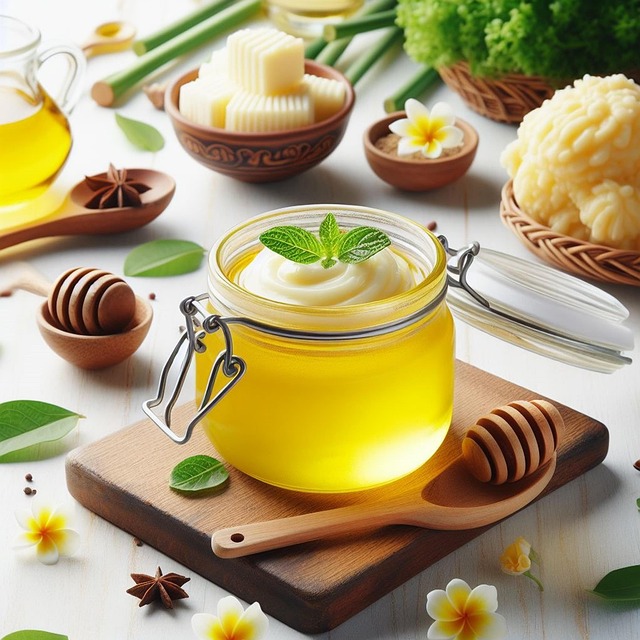If you’ve heard friends talk about “A2 milk” and wondered what the fuss is about, this guide is for you. We’ll keep it simple and practical—what A2 milk is, where it comes from, how it’s different from regular milk, and why many homes are switching to A2 ghee for everyday cooking.
What is A2 milk?
Milk contains many proteins. One of the main ones is beta-casein. There are two common types of beta-casein in cow’s milk: A1 and A2.
- A2 milk comes from cows that naturally produce only the A2 type of beta-casein.
- Regular milk in the market often has a mix of A1 + A2 proteins.
That’s really the core idea. Nothing fancy is added or removed. It’s about the cow’s genetics, not a processing trick.
Does A2 taste different?
Most people find the taste of A2 milk similar to regular milk—fresh, creamy, and familiar. The difference is more about the protein type than flavor.
What about digestion?
Some people say A2 milk feels gentler on their stomach. Scientific research is still evolving, and everyone’s body is different. If you’re sensitive to milk, it can be worth trying A2 to see how you feel. (If you have lactose intolerance or a medical condition, talk to your healthcare professional.)
Which cow breeds produce A2 milk?
Many Indian native (desi) breeds tend to carry the A2 gene. Common examples include:
- Gir
- Sahiwal
- Red Sindhi
- Tharparkar
- Rathi
- Kankrej
Some international breeds can also be A2, but it varies cow by cow. That’s why responsible farms genetically test their cows to confirm which ones are A2/A2.
Good to know: A2 milk is not the same as organic, grass-fed, or hormone-free—those are separate farming choices and labels. You can have A2 milk that is or isn’t organic, and vice-versa.
How do farms ensure milk is truly A2?
- Genetic testing of cows to identify A2/A2 animals.
- Dedicated milking and collection to avoid mixing with A1 milk.
- Batch-wise tracking so labels match what’s in the bottle or packet.
When you buy A2 milk, look for:
- Mention of A2/A2 genetics (not just “A2 style”).
- Breed details when available.
- Clear, transparent sourcing.
Nutrition basics of A2 milk
- Macros: Similar to regular milk—carbs (lactose), fats, and proteins.
- Micros: Calcium, phosphorus, B-vitamins, and more.
- Protein: The difference is the type of beta-casein (A2 instead of A1).
Remember, milk quality also depends on the cow’s diet (green fodder, seasonal grasses), farm hygiene, and how fresh the milk is.
A1 vs A2 in one glance
- What’s different? The beta-casein type: A1 vs A2.
- What’s similar? Most nutrients and taste.
- Who should switch? People who feel better on A2 can choose it. There’s no one-size-fits-all answer.
From A2 Milk to A2 Ghee: What changes?
Ghee is pure milk fat made by slowly heating butter to remove water and milk solids. The process concentrates flavor and gives ghee a long shelf life and high smoke point.
When ghee is made from A2 milk, you get A2 ghee—but note a key point:
- Ghee is almost entirely fat and contains negligible lactose and casein (the proteins)—that’s why many people who avoid milk proteins still tolerate ghee well.
- The “A2” tag here mainly tells you about the source milk and farming choice, and is valued by people who prefer A2 products end-to-end.
How A2 Ghee is traditionally made (Bilona method)
There are two broad ways to make ghee:
- Traditional “Bilona” method
- Whole A2 milk → set into curd
- Curd is churned (manually or with a wooden churner) to get makhan (cultured butter)
- Makhan is slow-heated to become ghee
- Why people love it: Depth of flavor, lovely aroma, and that signature grainy texture when it cools (“danedaar ghee”).
- Cream-based method
- Cream from milk is churned into butter, then clarified into ghee.
- Simpler, more industrial-friendly, but flavor can differ from bilona.
Both can produce safe, tasty ghee. If you’re after the classic aroma and texture, bilona often wins hearts.
What to look for when buying A2 Ghee
- Source transparency: Is the brand clear about breed (e.g., Gir, Sahiwal) and A2 testing?
- Method: Bilona/cultured vs cream-based—stated on the label or website.
- Aroma & texture:
- Color can vary with seasons and fodder (light yellow to deep golden).
- Slight graininess when set is a good sign for traditionally made ghee.
- Packaging: Dark glass or good quality containers help protect flavor.
- Batch details: Small-batch or batch numbers are a plus for traceability.
Cooking with A2 Ghee
- High smoke point: Great for tadka, shallow frying, roasting, and baking.
- Daily use ideas:
- A small dollop on rotis/parathas
- Tempering for dal, khichdi, sabzi
- Finishing touch on upma, poha, or rice
- Baking swaps where a rich, nutty flavor helps
Storage & shelf life
- Keep it tightly closed, away from heat and sunlight.
- Use a clean, dry spoon.
- Properly made ghee keeps well at room temperature; refrigeration is optional.
A2 Milk & A2 Ghee in Ayurveda (traditional lens)
In many Indian homes, ghee is considered “sattvic” and is used in daily food for richness and satisfaction. Traditional systems value ghee for agni (digestive fire) and use it in cooking, rituals, and wellness practices. This is cultural wisdom passed down for centuries. For medical conditions, always follow your doctor’s advice.
Common questions (quick answers)
Is A2 milk lactose-free?
No. A2 still contains lactose. People with lactose intolerance should be cautious and consult a professional.
Is A2 ghee lactose-free?
Ghee is almost entirely fat. It has negligible lactose and casein, which is why many people who avoid milk proteins do fine with ghee. Individual responses vary.
Is A2 automatically organic or grass-fed?
No. A2 refers only to the protein type in milk. Organic, grass-fed, hormone-free, etc., are separate labels.
Why is A2 ghee more expensive?
Native breeds often produce less milk per cow, farms may follow more careful practices, and bilona is labour-intensive. Costs reflect these choices.
Practical buying checklist
- A2/A2 genetic claim (preferably tested)
- Clear breed info (e.g., Gir, Sahiwal)
- Method (bilona/cultured vs cream-based)
- Batch details and storage advice
- Aroma, color, grainy texture when set
The bottom line
- A2 milk is simply milk from cows that naturally produce the A2 type of beta-casein.
- Many people choose it for personal comfort and preference.
- A2 ghee—especially when made the traditional bilona way—brings a deep, nutty aroma and is a versatile, reliable cooking fat for Indian kitchens.
If you’re building a cleaner, simpler pantry, adding a trusted A2 ghee is an easy win. It fits everyday Indian cooking and supports the timeless way our food is meant to taste.
Note: If you’re exploring options, Kesariya Farm makes A2 Ghee from native cow milk using careful, traditional methods. It’s a straightforward pick for daily home cooking
Image by Neha Singh from Pixabay (Free for commercial use)
Image Published on February 6, 2024




